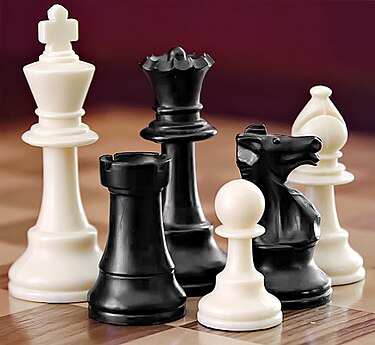Introduction
The rules of chess (also known as the laws of chess) govern the play of the game of chess. Chess is a
two-player
abstract strategy board game. Each player controls sixteen pieces of six types on a chessboard. Each type of
piece moves
in a distinct way. The object of the game is to checkmate the opponent's king; checkmate occurs when a king is
threatened with capture and has no escape. A game can end in various ways besides checkmate: a player can
resign, and
there are several ways a game can end in a draw.
While the exact origins of chess are unclear, modern rules first took form during the Middle Ages. The rules
continued
to be slightly modified until the early 19th century, when they reached essentially their current form. The
rules also
varied somewhat from region to region. Today, the standard rules are set by FIDE (Fédération Internationale des
Échecs),
the international governing body for chess. Slight modifications are made by some national organizations for
their own
purposes. There are variations of the rules for fast chess, correspondence chess, online chess, and Chess960.

Initial Setup
Chess is played on a chessboard, a square board divided into a grid of 64 squares (eight-by-eight) of
alternating color
(similar to the board used in draughts). Regardless of the actual colors of the board, the lighter-colored
squares
are called "light" or "white", and the darker-colored squares are called "dark" or "black". Sixteen "white" and
sixteen
"black" pieces are placed on the board at the beginning of the game. The board is placed so that a white square
is in
each player's near-right corner. Horizontal rows are called ranks, and vertical columns are called files.
Each player controls sixteen pieces:
At the beginning of the game, the pieces are arranged as shown in the diagram: for each side one king, one
queen, two
rooks, two bishops, two knights, and eight pawns. The pieces are placed, one per square, as follows:
Rooks are placed on the outside corners, right and left edge.
Knights are placed immediately inside of the rooks.
Bishops are placed immediately inside of the knights.
The queen is placed on the central square of the same color of that of the piece: white queen on the white
square and
black queen on the black square.
The king takes the vacant spot next to the queen.
Pawns are placed one square in front of all of the other pieces.
Popular mnemonics used to remember the setup are "queen on her own color" and "white on right".The latter refers
to
setting up the board so that the square closest to each player's right is white.
GamePlay
The player controlling the white pieces is named "White"; the player controlling the black pieces is named "Black". White moves first, then players alternate moves. Making a move is required; it is not legal to skip a move, even when having to move is detrimental. Play continues until a king is checkmated, a player resigns, or a draw is declared, as explained below. In addition, if the game is being played under a time control, a player who exceeds the time limit loses the game unless they cannot be checkmated. The official chess rules do not include a procedure for determining who plays White. Instead, this decision is left open to tournament-specific rules (e.g. a Swiss system tournament or round-robin tournament) or, in the case of non-competitive play, mutual agreement, in which case some kind of random choice is often employed. A common method is for one player to conceal a piece (usually a pawn) of each color in either hand; the other player chooses a hand to open and receives the color of the piece that is revealed.
